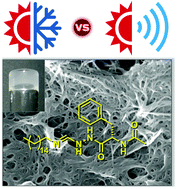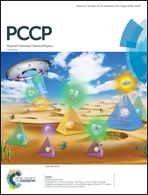Ultrasonication-enhanced gelation properties of a versatile amphiphilic formamidine-based gelator exhibiting both organogelation and hydrogelation abilities†
Abstract
We describe the preparation of a novel amphiphilic gelator built from a formamidine core, which is able to form a variety of physical organogels and hydrogels at concentrations ranging from 15 to 150 mg mL−1. Interestingly, ultrasound treatment of isotropic solutions (i.e., gel-precursor) resulted in a remarkable enhancement of the gelation kinetics as well as the gelation scope and characteristic gel properties (e.g., critical gelation concentration, gel-to-sol transition temperature, viscoelastic moduli) in comparison to the heating–cooling protocol typically used to obtain supramolecular gels. Thermoreversibility, thixotropy, injectability and multistimuli responsiveness are some of the most relevant functionalities of these gels. Electron microscopy imaging revealed the formation of entangled networks made of fibers of nanometer diameters and micrometer lengths, with different morphological features depending on the solvent. Insights into the driving forces for molecular aggregations were obtained from FTIR, NMR, PXRD and computational studies. The results suggest a major stabilization of the fibers through additive N–H⋯O hydrogen bonds, in combination with hydrophobic interactions, over π–π stacking interactions.



 Please wait while we load your content...
Please wait while we load your content...